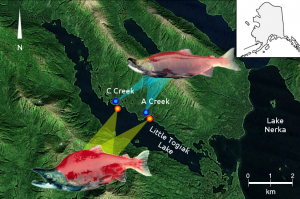In a project initiated in 1996 by Ray Hilborn as part of the Alaska Salmon Program, we are investigating the evolutionary and demographic dynamics of two Alaskan sockeye salmon populations (A and C creeks) by establishing full pedigrees. Adjacent to the two streams are several beach spawning populations that occasionally produce immigrants into the two creeks. Beach and creek spawning populations have strikingly different phenotypes, caused by sexual selection for deep bodies on the beach, and bear selection for shallow body in the creek (Fig 1).

With the help of the Alaska Salmon Program field crews, we have sampled salmon exhaustively in both creeks since 2004, i.e. we have full pedigrees over three generations. What we have found out so far:
- There is straying (dispersal) between the two creeks as well as between the beach and the creeks, more than suggested by gene flow estimates from genetic population differentiation. However, that dispersal is biased by phenotype: dispersers from beach to creek tend to be smaller than other beach fish, and dispersers from creek to beach are larger than other creek fish (Lin et al. 2008).
- Reproductive success is highly variable, with most fish producing no offspring, and some being very successful (Peterson et al 2014)
- Dispersers from beach into the creek have significantly lower reproductive success than other creek spawners, whether born in the same creek or the other creek (Peterson et al. 2014)
- Dispersers between creeks explored their natal creek before straying to the other, suggesting that dispersal is an active choice rather than a navigation error (Peterson et al 2015)
- Bear predation was highly variable between years, but although bears preferred bigger and ‘fresher’ (more recently arrived) fish, they exerted little selection on return timing, length or depth of the fish. However, fish in high predation years had shorter life expectancy and fewer offspring than those in low predation years. Bear predation therefore had considerable demographic but little evolutionary effects (Lin et al 2016)
This work is now continued by Sam May, a graduate student of Kerry Naish.